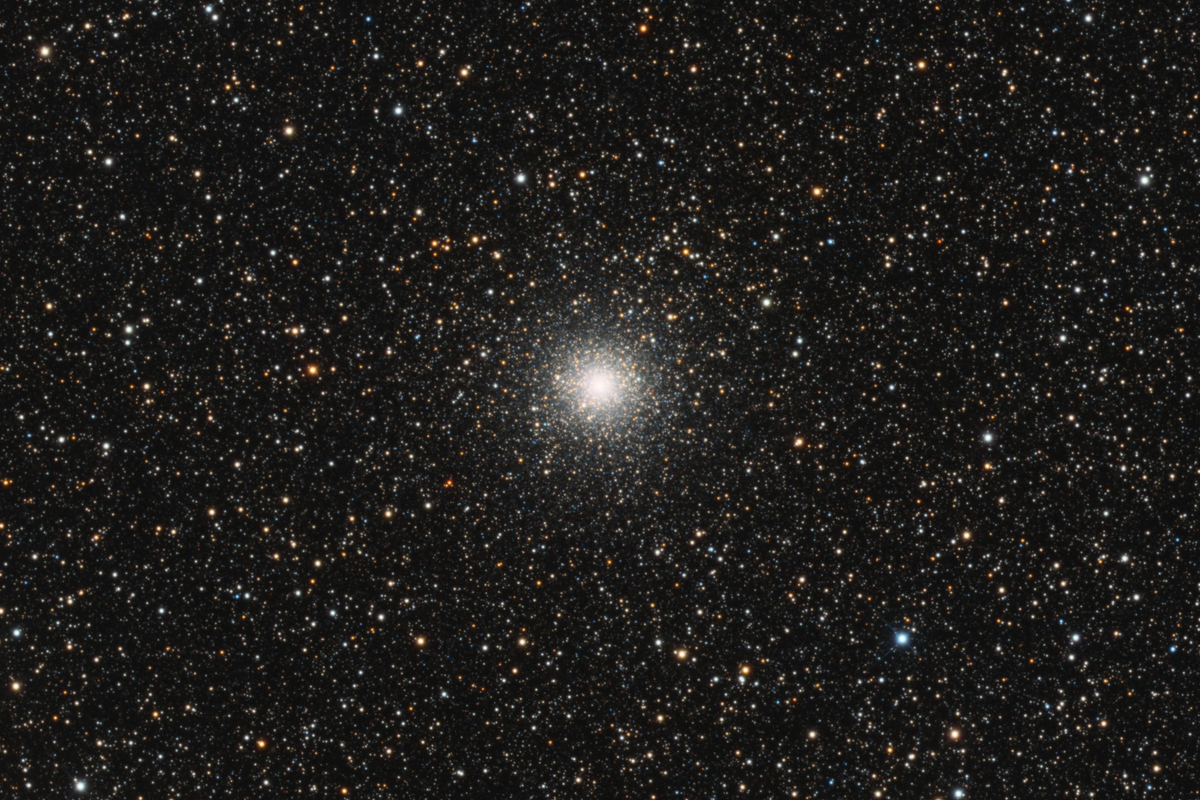
[back] M 54
in Sagittarius [NED]
Big,
uncroped 100%
image version / Große, 100% Bild-Version (9456 x 6227
pixel, 0.743"/pixel)
Anotated Version (9456 x 6227
pixel, 0.743"/pixel)

|
(c) 2025 All astro photo images are copyrighted. They may not be used or reproduced without explicit written permission from the authors. |
|
300" |
|
About this Image / Über dieses Bild
| Camera: | Moravian C3-PRO-61000 Mono CMOS |
| Image Type, Orientation: | RGB Color Composite, North is at 12:00 |
| Exposure time: | RGB: 24/30/24 x 180s (3:54h total) |
| Exposure date: | July 14th, 2025 |
| Location: | Capella Observatory South at Kiripotib Astro Farm, Namibia |
| Filter: | Astronomik Deep-Sky Deep-Sky RGB Filter on Moravian EFW-3L-9-II External Filter Wheel |
| Instrument: | "Rhea", a PlaneWave DeltaRho 350, 1050mm focal length, 350mm aperture, f/3 on 10Micron GM2000 HPS II Combi |
| Photographer: | Rainer Raupach, Josef Pöpsel, Frank Sackenheim, Stefan Binnewies |
| Remarks: |
Messier 54 is a long-known globular cluster in the
constellation Sagittarius, discovered by Charles Messier in 1771. However,
it was not until 1994 that astronomers determined that M54, unlike most
other globular clusters in the Messier catalog, does not belong to the Milky
Way’s halo, but rather to the Sagittarius Dwarf Elliptical Galaxy (SagDEG)
[1,a]. Consequently, M54 is classified as an extragalactic object and,
interestingly, is located at the center of the SagDEG. Whether this location
is the result of orbital decay due to dynamical friction [2], or whether the
cluster is in fact the remnant nucleus of the dwarf galaxy itself [3],
remains a subject of ongoing debate. In 2009, a intermediate-mass black hole — estimated at roughly 10,000 solar masses — was detected at the core of M54 [4]. [a] The only other known exception within the Messier catalog is M79, which is thought to belong either to the Canis Major Dwarf Galaxy or to the so-called “Gaia Sausage” — the debris of the Gaia-Enceladus galaxy, resulting from its merger with the Milky Way. |
|
|
|
| Bemerkungen: |
Messier 54 ist ein schon lange
bekannter Kugelsternhaufen im Sternbild Schütze, entdeckt von Charles
Messier im Jahr 1771. Dennoch wurde erst 1994 aufgedeckt, dass M 54 nicht
wie die meisten anderen Kugelsternhaufen im Messier-Katalog zum Halo der
Milchstraße gehört, sondern zur Sagittarius-Zwerggalaxie (Sagittarius Dwarf
Elliptical Galaxy = SagDEG) [1,a]. Damit ist M 54 ein extragalaktisches
Objekt und liegt interessanterweise im Zentrum der SagDEG. Ob dieser
Aufenthaltsort eine Folge der Bewegung aufgrund von dynamischer Reibung [2]
oder der Kugelsternhaufen sogar der Kern der Zwerggalaxie ist [3], wird noch
diskutiert. |
|
|
|
| References: |
[1] Siegel, Michael H.; Dotter, Aaron; Majewski, Steven
R.; Sarajedini, Ata; et al. (2007). "The ACS Survey of
Galactic Globular Clusters: M54 and Young Populations in the Sagittarius
Dwarf Spheroidal Galaxy". Astrophysical Journal
Letters. 667 (1): L57–L60.
https://arxiv.org/abs/0708.0027 [2] Bellazzini, M.; Ibata, R. A.; Chapman, S. C.; Mackey, A. D.; et al. (2008). "The Nucleus of the Sagittarius Dsph Galaxy and M54: a Window on the Process of Galaxy Nucleation". The Astronomical Journal. 136 (3): 1147–1170. https://arxiv.org/abs/0807.0105[3] Carretta, E.; Bragaglia, A.; Gratton, R. G.; Lucatello, S.; et al. (2010). "M54 + Sagittarius = ω Centauri". The Astrophysical Journal Letters. 714 (1): L7 – L11. https://arxiv.org/abs/1002.1963[4] Ibata, R.; Bellazzini, M.; Chapman, S. C.; Dalessandro, E.; et al. (2009). "Density and Kinematic Cusps in M54 at the Heart of the Sagittarius Dwarf Galaxy: Evidence for a 10^4 M☉ Black Hole?". Astrophysical Journal Letters. 699 (2): L169–L173. https://arxiv.org/abs/0906.4894 |
Back to the Globular Clusters Overview / Zurück zur Kugelsternhaufen-Übersichtsseite